Department of Advanced Photon Research
Advanced Laser Group
Leader: KIRIYAMA Hiromitsu
Group member
| KIRIYAMA Hiromitsu | Group Leader |
| FUKUDA Yuji | Senior Principal Researcher |
| ALEXANDER Pirozhkov | Senior Principal Researcher |
| OGURA Koichi | Senior Expert |
| SAGISAKA Akito | Principal Researcher |
| MIYASAKA Yasuhiro | Senior Researcher |
| MASHIBA Yuji | Engineer |
| NISHIUCHI Mamiko | Senior Principal Researcher (concurrent post) |
| KONDO Kotaro | Senior Researcher (concurrent post) |
| KON Akira | Senior Engineer (concurrent post) |
| MINAMI Takumi | QST Research Assistant |
| WATANABE Kento | QST Research Assistant |
| MOCHIZUKI Seiichiro | QST Research Assistant |
| INOUE Chihiro | QST Research Assistant |
| TODA Hiroyuki | Visiting Researcher (Doshisha University) |
| Laser Facility Operation Office | Laser Operation Cooperation |
Overview and activities
Overview
We are conducting research on the world's most advanced ultra-high-intensity laser which contributes to applications in academic development, medical science and so on. By focusing an ultra-high-intensity laser and irradiating matter, it is possible to generate high-temperature and high-pressure states and strong electric and magnetic fields which cannot be reached by other existing methods. "High energy density science" to study such extreme states (high energy density states) is being actively researched in the world. Kansai Photon Science institute (KPSI) is advancing research and development utilizing the framework of "Collaboration and Cooperation on High Energy Density Science" by the Ministry of Education, Culture, Sports, Science and Technology (MEXT) and the US Department of Energy (DOE).
Activities
1) Ultra-high intensity “J-KAREN” laser development
We are developing the laser, named J-KAREN, which produces an ultra-high intensity output of 1,000 trillion W (= 1 petawatt = 1 PW) equivalent to 1 million units of 1 million kW (=1 gigawatt) class thermal power plants in the extremely short time of about 1/30 trillion seconds (30 femtoseconds = 30 fs) and advanced technology for the laser beam. Although competition for the development of petawatt-class lasers is fierce in the world, the J-KAREN laser has world-class performance in terms of temporal quality (contrast performance) and spatial quality (focusing performance), which are the most important in experiments. In 2012, we have achieved the world's highest contrast performance which suppresses temporal optical noise to one trillionth of the laser main pulse intensity, and in 2020, we have eliminated many unnecessary pulses that precede the laser main pulse. In 2017, we have succeeded in producing the world's highest at-focus peak intensity of 1022 W / cm2. In collaboration with the High Intensity Laser Science Group, we are also working on the technology called plasma mirrors for ultra-high contrast performance.
With support from the Ministry of Education, Culture, Sports, Science and Technology (MEXT) of Japan, we are constructing a network among Japan's leading power laser facilities (Institute of Laser Engineering, Osaka University; The Institute for Solid State Physics, The University of Tokyo; Institute for Chemical Research, Kyoto University; and RIKEN SPring-8 Center), including the maintenance and operation of the facilities. This will contribute to the sustainable maintenance and development of Japan's research and development infrastructure by creating a nationwide platform with advanced support systems for all researchers.
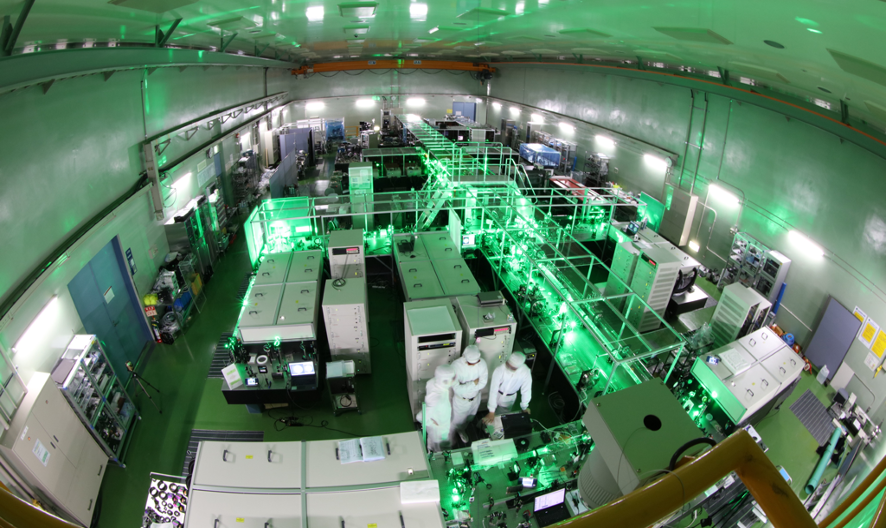
Fig. 1. View of the J-KAREN (Japan-Kansai Advanced Relativistic Engineering) laser.
Kiriyama et al., Opt. Lett. (2018/2020).
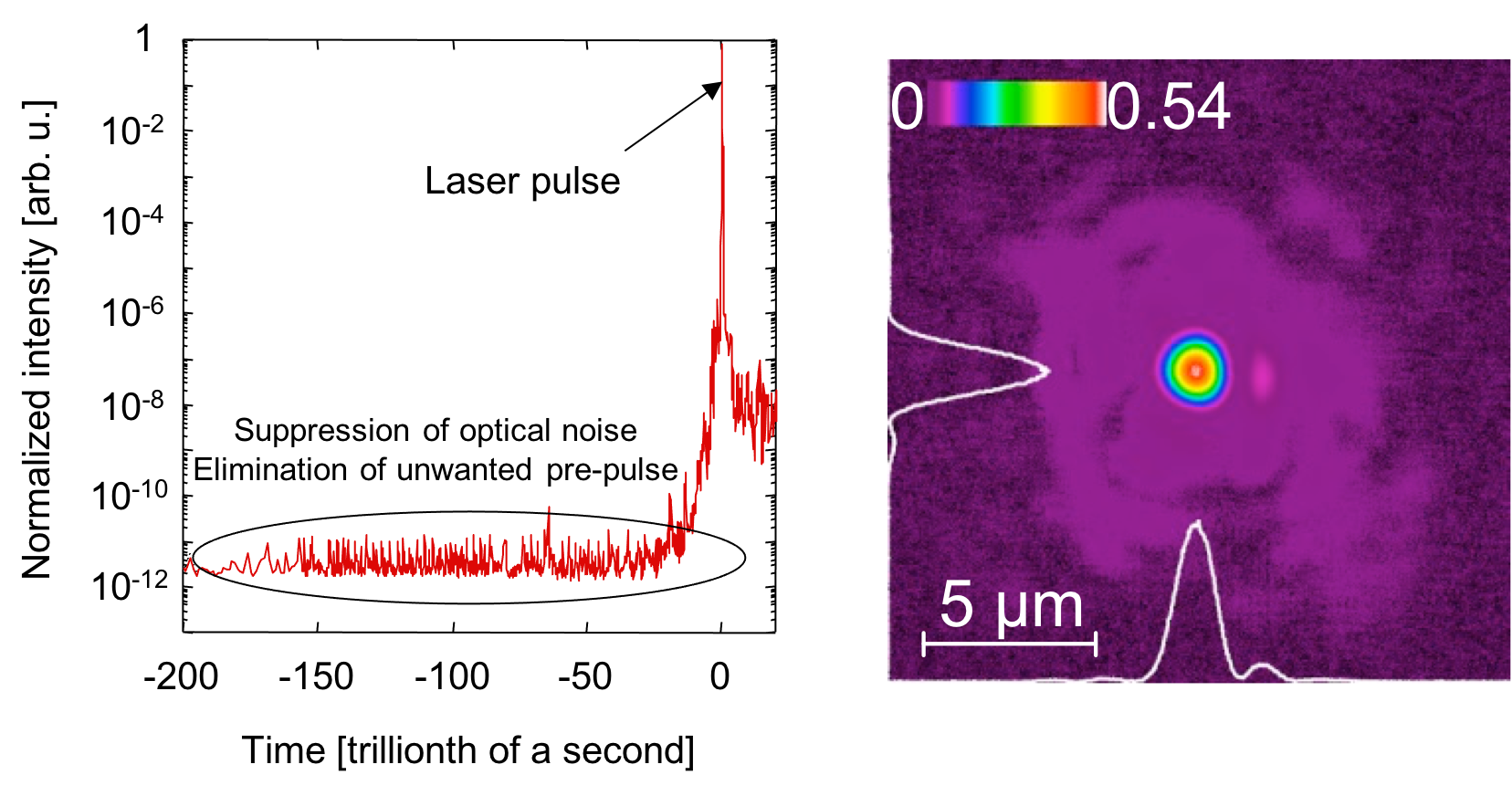
Fig. 2. The J-KAREN laser beam was successfully focused to a small time-space region, achieving world-class temporal quality (left) and spatial quality (right).
Pirozhkov et al., Opt. Express. (2017).
Kiriyama et al., High Power Laser Sci. Eng. (2021).
2) Advanced laser technology
2-1) High stability laser source
We are researching and developing new technologies that can be used for the advancement and stabilization of various lasers including the J-KAREN laser. In order to obtain stable output power in optical parametric amplification, the timing of the pump laser and the signal laser to be amplified at the amplifier must be precisely synchronized. However, synchronizing the two oscillators electrically causes a timing jitter. We are developing an optically synchronous pump laser with a single oscillator to eliminate this jitter by creating a pump laser from the amplified laser output from the oscillator. The photonic crystal fiber is used to shift the wavelength (corresponding to the color of light) from the amplified laser to the seed for the pumped laser. We have been working on creating a long-pulse pump laser for use with ultra-intense lasers such as the J-KAREN laser. We have succeeded in generating a high energy nanosecond order laser pulse at a wavelength of 532nm with high stability. We are developing a high-intensity OPCPA laser using this highly stable pumping laser.

Fig. 3. Shifting the wavelength of the amplified laser using a photonic crystal fiber to generate the seed for the pump laser.
2-2) Optics for high average power laser
The efficiency of the experiment and the range of applications is enhanced as more laser pulses are emitted per second. However, the thermal load on the laser system, mirrors, and other components will increase rapidly if the pulse energy is maintained with a high repetition rate. Heat accumulation and temperature rise will cause surface distortion of the mirrors and other optical components due to thermal expansion, which will degrade the quality of the laser propagating through the mirrors. We focused on sintered silicon carbide (SiC) to reduce the heat load, which has a high thermal conductivity. By using sintered SiC as a substrate, which has a thermal conductivity 130 times higher than that of widely used glass substrates, we have significantly reduced the substrate’s temperature rise by quickly removing heat (Fig. 4). In the future, we would like to develop optical element substrates withstanding higher average power by taking on the challenge of water cooling from inside the substrate.

Fig. 4. Thermal load-resistant optics using sintered silicon carbide (SiC) as a substrate (left) and how the temperature changes during heating (right).
Miyasaka et al., Crystals (2020).
2-3) Coherent beam combing
Increasing the pulse energy is commonly used to enhance the intensity of the laser. However, there are technical limitations on the size of the laser crystals manufactured for use in large-aperture amplifiers. To solve this problem, we are developing a coherent beam coupling technique, in which laser beams are divided into multiple beams, amplified using a small laser crystal, and then re-coupled. This technique has been used mainly for fiber lasers. We are working on fundamental research to develop a simple coupling method for large lasers such as the J-KAREN laser without the feedback control to combine multiple lasers. This research is in collaboration with Doshisha University.
a)
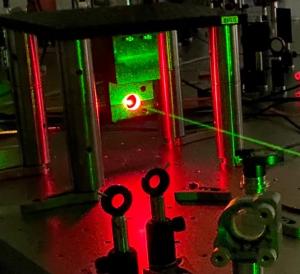
b)

c)
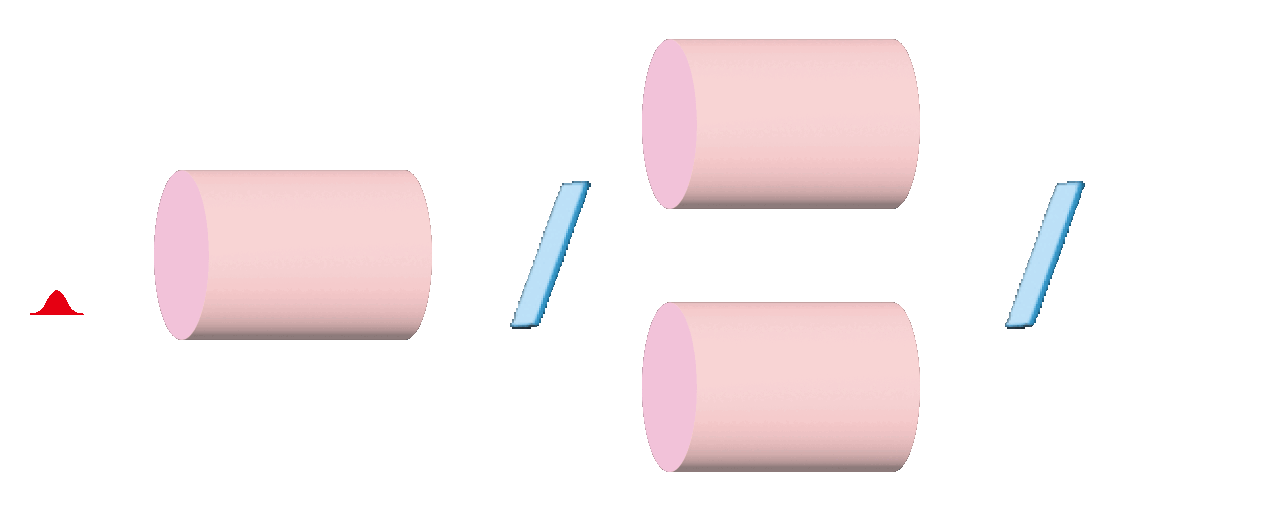
Fig. 5. (a) Image of an excited Ti:sapphire crystal pumped by a green laser. (b) Image of a typical laser amplification. Conventional methods cannot amplify beyond the damage limit of the laser crystal. Intense lasers break the laser crystal. (c) Image of laser amplification with coherent beam combining. By splitting lasers and amplifying them to the limit of their damage threshold and then combining them, a higher energy laser pulse can be produced. We are investigating methods for simple and precise laser beam combining.
3) Ultra-High Intense Laser Field Sciences in Extreme Conditions
3-1) Laser ion acceleration at nearly the speed of light using astrophysical approach
It is believed that cosmic rays that fall on the Earth have a velocity larger than 99% of the speed of light, and that most of them are particles accelerated statistically by shocks (called collisionless shocks) associated with the supernova explosion that occurs when the star reaches the end of its life (Fig. 6). High-intensity lasers enabled the production of materials in extreme conditions of ultra-high temperature and ultra-high pressure that human beings have never experienced before, and made it possible to accelerate the particles on the Earth by using collisionless shocks in the laboratory. By using large-scale computer simulations, in collaboration with Kyoto University, we discovered a new phenomenon of ion acceleration, named CSBA (= Converging Shock-induced Blow-off Acceleration) (patent pending): When a laser is irradiated to a "spherical" object such as a cluster, a crescent-shaped collisionless shock is launched at the laser-irradiated hemisphere and propagates inward. The shock converges at the sphere center in concurrence with the onset of the relativistically induced transparency (RIT), allowing the proton bunch to be pushed out from the shock surface in the laser propagation direction (Fig. 6). The proton bunch experiences further acceleration both inside and outside of the cluster to finally exhibit a quasimonoenergetic spectral peak around 300 MeV (70 % of the speed of light).
We have succeeded in developing the unique device to generate micron-scale hydrogen clusters, and in generating multi-MeV high-purity proton beams at 0.1 Hz (Fig. 7). Currently, using the J-KAREN laser, we are conducting joint research toward the realization of laser ion acceleration approaching the speed of light by using CSBA in collaboration with external collaborators (Kobe University, Osaka University, Kyoto University, Nagoya University, The University of Tokyo, Tohoku University, Queen's University Belfast (UK), Joint institute for High Temperatures of the Russian Academy of Sciences (Russia), etc.).
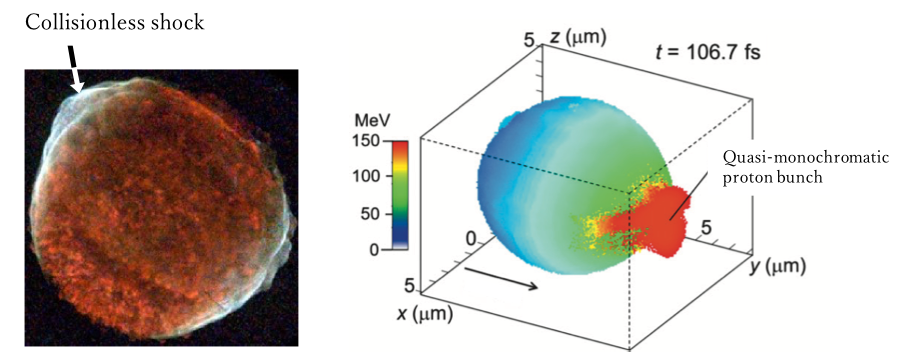
Fig. 6. (Left) Cosmic ray acceleration due to collisionless shock is occurring on the surface of the supernova remnant SN1006. (Right) Result of large-scale computer simulation of interaction between high-intensity laser and hydrogen cluster (three-dimensional diagram). Energy distribution of protons accelerated by CSBA: A quasi-monochromatic proton beam (red bunch) accelerated by the shock at the center of the cluster fly away from the inside of the cluster to the outside, and is accelerated further to sub-GeV energies by the Coulomb explosion electric field in the laser propagation direction (+ y direction).
Matsui, Fukuda, Kishimoto, Phys. Rev. Lett. (2019).
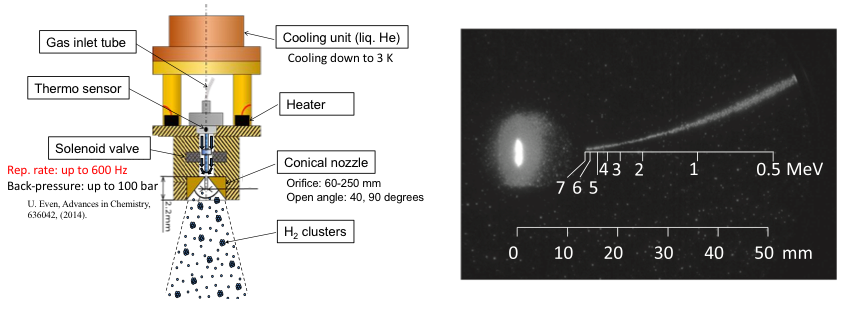
Fig. 7. (Left) Temperature-controllable hydrogen cluster generation system, originally developed by ourselves and capable of generating micron-scale hydrogen clusters. (Right) Single-shot signal of multi-MeV high-purity protons measured by real-time Thomson parabola, developed by ourselves.
Jinno, Fukuda et al., Opt. Exp. (2017).
Jinno, Fukuda et al., PPCF (2018).
3−2) Burst Intensification by Singularity Emitting Radiation (BISER)
– a novel general mechanism of phase-synchronized radiation in the Universe –
[Summary]
• In 2017 we discovered point-like nano-scale sources of extremely bright phase-synchronized ultrashort x-rays in relativistic plasma driven by super-intense laser.
• The laser induces converging flows which make density singularities of electrons; their collective soft x-ray emission thus becomes coherent and extremely intensified.
• This general mechanism embraces any types of travelling waves, including gravitational ones, and should be present in black holes, supernovas, relativistic cosmic jets, etc.
[Description]
In nature, flows are ubiquitous such as rivers, winds, and cosmic plasma. In a converging flow, regions of extreme density concentration appear. They look like density spikes. In mathematics they are called "singularities" and are categorized into several groups by catastrophe theory. What happens if such density singularities appear in a medium which can emit travelling waves such as electro-magnetic, acoustic, or gravitational types? We made a dedicated experiment searching for emitting singularities in laser-plasma created by the J-KAREN laser at KPSI, QST in Kizugawa. We discovered the coherent soft X-ray emission which was originated from point-like nano-scale sources.
This finding answers the above question: a high concentration in emitting medium produces extremely bright phase-synchronized (coherent) radiation due to the constructive interference (synergy) of the waves from individual emitters. We call this mechanism BISER (Burst Intensification by Singularity Emitting Radiation). Surprisingly, this general effect was overlooked for 40 years after the triumph of the catastrophe theory.
The radiation obtained in the current experiment is in the region of soft X-rays. In the future, it can be extended to shorter-wavelength X-rays which will allow research on the creation of new medicines and functional materials with compact facilities in university and industry laboratories. In a wider perspective, the BISER is universal mechanism applicable to matter flows having singularities such as shocks in auroras near the Earth poles and supernova explosion, and matter singularities near black holes emitting gravitational waves. Thus, the BISER concept will be beneficial for understanding various phenomena in the Universe.
The results of the research were published in the following paper:
A. S. Pirozhkov*, T. Zh. Esirkepov*(these authors contributed equally), T. A. Pikuz, A. Ya. Faenov, K. Ogura, Y. Hayashi, H. Kotaki, E. N. Ragozin, D. Neely, H. Kiriyama, J. K. Koga, Y. Fukuda, A. Sagisaka, M. Nishikino, T. Imazono, N. Hasegawa, T. Kawachi, P. R. Bolton, H. Daido, Y. Kato, K. Kondo, S. V. Bulanov, and M. Kando, "Burst intensification by singularity emitting radiation in multi-stream flows," Scientific Reports 7, 17968 (21 Dec 2017), DOI: 10.1038/s41598-017-17498-5.
QST Press release (in Japanese): 「プラズマの特異点からの強力な軟X線バーストを発見-宇宙でも起こり得る普遍的な新しい放射機構の提案-」
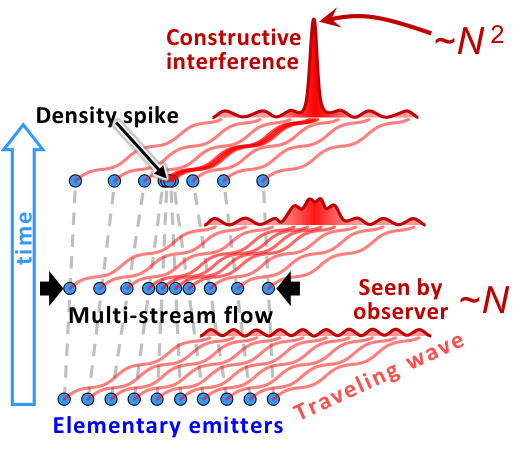
Fig. 8. Formation of a singularity (density spike) and corresponding burst intensification of emitted radiation. A multi-stream converging flow consisting of elementary emitters emitting with intensity proportional to N eventually forms a density spike capable of generating a burst of coherent emission due to the constructive interference, intensity ~ N2.
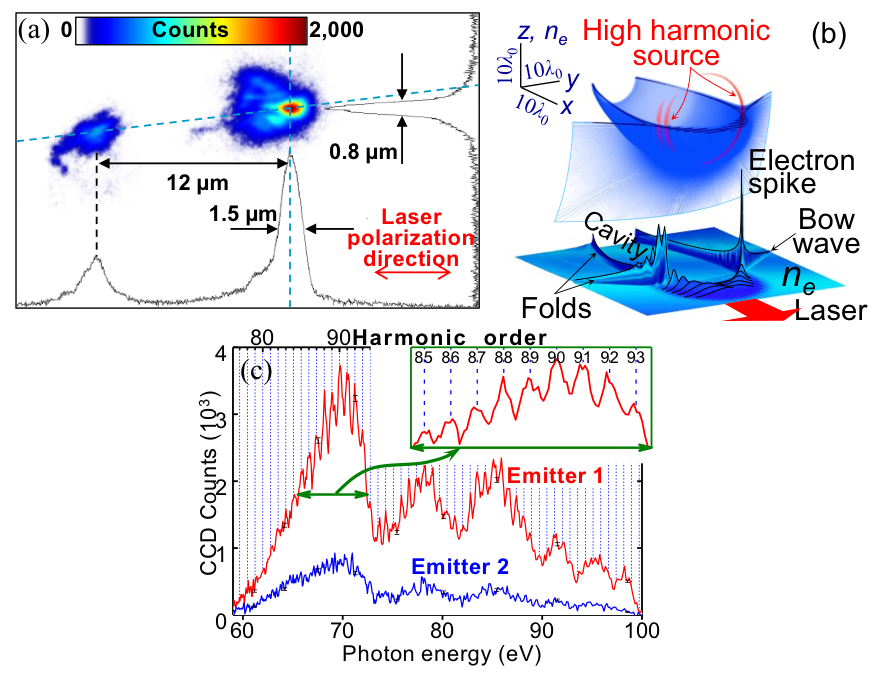
Fig. 9. BISER in the experiment and simulations. (a) Singular emitters revealed in experiment. Single-shot image produced on the LiF plate by photons with the energy from 60 to 100 eV. The solid lines show lineouts along the light dashed lines. (b) 3D PIC simulation demonstrating the fold singularities (cavity wall and bow wave front) and the cusp singularity (electron density spike) at the joining of the two folds. This sike is the source of high-order harmonics (BISER radiation). (c) High-order harmonic spectra of BISER coherent source in the experiment.
Publication Lists
1. Papers (peer-reviewed)
2022
- “A multi-stage scintillation counter for GeV-scale multi-species ion spectroscopy in laser-driven particle acceleration experiments”
Y. Abe, H. Kohri, A. Tokiyasu, T. Minami, H. Iwasaki, T. Taguchi, T. Asai, M. Kanasaki, S. Kodaira, S. Fujioka, Y. Kuramitsu, and Y. Fukuda, Rev. Sci. Instrum. 93, 063502 (2022).
DOI:10.1063/5.0078817 - “Robustness of large-area suspended graphene under interaction with intense laser”
Y. Kuramitsu, T. Minami, T. Hihara, K. Sakai, T. Nishimoto, S. Isayama, Y.T. Liao, K.T. Wu, W.Y. Woon, S.H. Chen, Y.L. Liu, S.M. He, C.Y. Su, M. Ota, S. Egashira, A. Morace, Y. Sakawa, Y. Abe, H. Habara, R. Kodama, L. N. K. Dohl, N. Woolsey, M. Koenig, H. S. Kumar, N. Ohnishi, M. Kanasaki, T. Asai, T. Yamauchi, K. Oda, Ko. Kondo, H. Kiriyama, and Y. Fukuda, Scientific Reports 12, 2346 (2022).
DOI:10.1038/s41598-022-06055-4 - “In-Target Proton–Boron Nuclear Fusion Using a PW-Class Laser”
D. Margarone, J. Bonvalet, L. Giuffrida, A. Morace, V. Kantarelou, M. Tosca, D. Raffestin, P. Nicolai, A. Picciotto, Y. Abe, Y. Arikawa, S. Fujioka, Y. Fukuda, Y. Kuramitsu, H. Habara, and D. Batani, Applied Sciences 12, 1444 (2022).
DOI:10.3390/app12031444 - “極端紫外 (EUV) 域低入射角高回折効率ラミナー型回折格子の設計”
小池 雅人, 村野 孝訓, 越谷 翔悟, 羽多野 忠, ピロジコフ アレキサンダー, 垣尾 翼, 林 信和, 長野 哲也, 近藤 公伯, 寺内 正己, X線分析の進歩, 53, 70 (2022).
2021
- “Enhancement of pre-pulse and picosecond pedestal contrast of the petawatt J-KAREN-P laser”
H. Kiriyama, Y. Miyasaka, A. Kon, M. Nishiuchi, A. Sagisaka, H. Sasao, A. S. Pirozhkov, Y. Fukuda, K. Ogura, Ko. Kondo, M. Kando, and N. P. Dover, High Power Laser Science and Engineering, 9, e62 (2021).
DOI:10.1017/hpl.2021.51 - “Discriminative detection of laser-accelerated multi-MeV carbon ions utilizing solid state nuclear track detectors”
T. Hihara, M. Kanasaki, T. Asai, T. Kusumoto, S. Kodaira, H. Kiriyama, K. Oda, T. Yamauchi, W.-Y. Woon, Y. Kuramitsu, and Y. Fukuda, Scientific Reports, 11, 16283 (2021).
DOI:10.1038/s41598-021-92300-1 - “Broadband normal-incidence mirrors for a range of 111–138 Å based on an a-periodic Mo/Be multilayer structure”
M. M. Barysheva, S. A. Garakhin, A. O. Kolesnikov, A. S. Pirozhkov, V. N. Polkovnikov, E. N. Ragozin, A. N. Shatokhin, R. M. Smertin, M. V. Svechnikov, and E. A. Vishnyakov, Optical Materials Express, 11, 3038 (2021).
DOI:10.1364/OME.434506 - “Deconvolution of X-ray Spectra from Linear Absorption Spectrometer via Parameter Reduction and Merit-Function Optimisation Routine”
C. D. Armstrong, D. Neely, D. Kumar, P. McKenna, R. J. Gray, and A. S. Pirozhkov, Review of Scientific Instruments, 92, 113102 (2021).
DOI:10.1063/5.0057486 - “Relativistic flying laser focus by a laser-produced parabolic plasma mirror”
T. M. Jeong, S. Bulanov, P. Valenta, G. Korn, E. Zh. Timur, J. K. Koga, A. S. Pirozhkov, K. Masaki, and S. S. Bulanov, Physical Review A, 104, 053533 (2021).
DOI:10.1103/PhysRevA.104.053533 - “Design and experimental evaluation of enhanced diffraction efficiency of lanthanum-based material coated laminar-type gratings in boron K-emission region”
T. Hatano, M. Koike, M. Terauchi, A. S. Pirozhkov, N. Hayashi, H, Sasai, and T. Nagano, Applied Optics, 60, 4993 (2021).
DOI:10.1364/AO.430802 - “Highly stable sub-nanosecond Nd:YAG pump laser for optically synchronized optical parametric chirped-pulse amplification”
Y. Miyasaka, Ko. Kondo, M. Kishimoto, M. Mori, M. Kando, and H. Kiriyama, Optics express, 29, 32404 (2021).
DOI:10.1364/OE.430953 - “Energetic α-particle sources produced through proton-boron reactions by high-energy high-intensity laser beams”
J. Bonvalet, Ph. Nicolaï, D. Raffestin, E. D’humieres, D. Batani, V. Tikhonchuk, V. Kantarelou, L. Giuffrida, M. Tosca, G. Korn, A. Picciotto, A. Morace, Y. Abe, Y. Arikawa, S. Fujioka, Y. Fukuda, Y. Kuramitsu, H. Habara, and D. Margarone, Physical Review E 103, 053202 (2021).
DOI: 10.1103/PhysRevE.103.053202 - “Proton beam quality enhancement by spectral phase control of a PW‑class laser system”
T. Ziegler, D. Albach, C. Bernert, S. Bock, F.‑E. Brack, T. E. Cowan, N. P. Dover, M. Garten, L. Gaus, R. Gebhardt, I. Goethel, U. Helbig, A. Irman, H. Kiriyama, T. Kluge, K. Akira, S. Kraft, F. Kroll, M. Loeser, J. Metzkes‑Ng, N. Mamiko, L. Obst‑Huebl, T. Püschel, M. Rehwald, H.‑P. Schlenvoigt, U. Schramm, and K. Zeil,Scientific Report, 11, 7338 (2021).
DOI:10.1038/s41598-021-86547-x - “Analysis of Lyα dielectronic satellites to characterize temporal profile of intense femtosecond laser pulses”
S. N. Ryazantsev, I. Yu. Skobelev, A. S. Martynenko, M. A. Alkhimova, M. D. Mishchenko, M. V. Sedov, T. A. Pikuz, Y. Fukuda, H. Kiriyama, A. S. Pirozhkov, and S. A. Pikuz, Crystals, 11, 130 (2021).
DOI:10.3390/cryst11020130 - “Optimization and stabilization of a kilohertz laser-plasma accelerator”
L. Rovige, J. Huijts, I. A. Andriyash, A. Vernier, M. Ouille, Z. Cheng, Takafumi Asai, Y. Fukuda, V. Tomkus, V. Girdauskas, G. Raciukaitis, J. Dudutis, V. Stankevic, P. Gecys, R. Lopez-Martens, and J. Faure, Physics of Plasmas, 28, 033105 (2021).
DOI:10.1063/5.0040926 - “Soft X-ray spectrometers based on aperiodic reflection gratings and their application”
E. N. Ragozin, E. A. Vishnyakov, A. O. Kolesnikov, A. S. Pirozhkov, A. N. Shatokhin, Physics-Uspekhi, 64 (5) (2021).
DOI:10.3367/UFNe.2020.06.038799
2020
- “Development of carbon thin film for Laser‐driven heavy ion acceleration using a XeCl excimer laser”
M. Kusaba, F. Nigo, K. Kondo, M. Nishiuchi, H. Sakaki, H. Kiriyama, M. Hashida, and S. Sakabe, IEEJ Transactions on Electrical and Electronic Engineering, 103, 16 (2020).
DOI:10.1002/ecj.12286 - “Characterization of Accumulated B-Integral of Regenerative Amplifier Based CPA Systems”
S. Bock, F. M. Herrmann, T. Püschel, U. Helbig, R. Gebhardt, J. J. Lötfering, R. Pausch, K. Zeil, T. Ziegler, A. Irman, T. Oksenhendler, A. Kon, M. Nishiuchi, H. Kiriyama, K. Kondo, T. Toncian, and U. Schramm, Crystals, 10, 847 (2020).
DOI:10.3390/cryst10090847 - “High intensity laser driven oxygen source from CW laser heated titanium tape targets”
Ko. Kondo, M. Nishiuchi, H. Sakaki, N. P. Dover, H. F. Lowe, T. Miyahara, Y. Watanabe, T. Ziegler, K. Zeil, U. Schramm, E. J. Ditter, G. S. Hicks, O. C. Ettlinger, Z. Najmudin, H. Kiriyama, M. Kando, and K. Kondo, Crystals, 10, 837 (2020).
DOI:10.3390/cryst10090837 - “High-thermal-conductivity SiC ceramic mirror for high-average-power laser system”
Y. Miyasaka, Ko. Kondo, H. Kiriyama, Crystals, 10, 831, (2020).
DOI:10.3390/cryst10090831 - “Petawatt femtosecond laser pulses from titanium-doped sapphire crystal”
H. Kiriyama, A. S. Pirozhkov, M. Nishiuchi, Y. Fukuda, A. Sagisaka, A. Kon, Y. Miyasaka, K. Ogura, N. P. Dover, Ko. Kondo, H. Sakaki, J. K. Koga, T. Zh. Esirkepov, K. Huang, N. Nakanii, M. Kando, K. Kondo, S. Bock, T. Ziegler, T. Püschel, K. Zeil, and U. Schramm, Crystals, 10, 783, (2020).
DOI:10.3390/cryst10090783 - “Single-shot measurement of post-pulse-generated pre-pulse in high power laser systems”
A. Kon, M. Nishiuchi, H. Kiriyama, M. Kando, S. Bock, T. Ziegler, T. Pueschel, K. Zeil, U. Schramm, and K. Kondo, Crystals, 10, 657 (2020).
DOI:10.3390/cryst10080657 - “Dynamics of Laser-driven Heavy Ion Acceleration Clarified by Ion Charge States”
M. Nishiuchi, N. P. Dover, M. Hata, H. Sakaki, K. Kondo, H. F. Lowe, T. Miyahara, H. Kiriyama, J. K. Koga, N. Iwata, M. Alklhimova, A. S. Pirozhkov, A. Faenov, P. Tatiana, A. Sagisaka, Y. Watanabe, M. Kando, K. Kondo, E. J. Ditter, O. Ettlinger, G. Hicks, N. Zuflkar, T. Ziegler, K. Zeil, U. Schramm, and Y. Sentoku, Physical Review Research, 2, 033081 (2020).
DOI:10.1103/PhysRevResearch.2.033081 - “Status and progress of the J-KAREN-P high intensity laser system at QST”
H. Kiriyama, A. S. Pirozhkov, M. Nishiuchi, Y. Fukuda, K. Ogura, A. Sagisaka, Y. Miyasaka, H. Sakaki, N. P.r Dover, K. Kondo, H. F. Lowe, A. Kon, J. K. Koga, T. Zh. Esirkepov, N. Nakanii, K. Huang, M. Kando, and K. Kondo, High Energy Density Physics, 36, 100771 (2020).
DOI:10.1016/j.hedp.2020.100771 - “Demonstration of repetitive energetic proton generation by ultra-intense laser interaction with a tape target”
N. P. Dover, M. Nishiuchi, H. Sakaki, Ko. Kondo, M. A. Alkhimova, A. Ya. Faenov, M. Hata, N. Iwata, H. Kiriyama, J. K. Koga, T. Miyahara, T. A. Pikuz, A. S. Pirozhkov, A. Sagisaka, Y. Sentoku, Y. Watanabe, M. Kando, K. Kondo, H. F. Lowe, E. J. Ditter, O. C. Ettlinger, G. S. Hicks, Z. Najmudin, U. Schramm, T. Ziegler, and K. Zeil, High Energy Density Physics, 37, 100847 (2020).
DOI:10.1016/j.hedp.2020.100847 - “Experimental investigation on temporal contrast of pre-pulses by post-pulses in a petawatt laser facility”
H. Kiriyama, Y. Miyasaka, A. Sagisaka, K. Ogura, M. Nishiuchi, A. S. Pirozhkov, Y. Fukuda, M. Kando, and K. Kondo, Optics Letters, 45, 1100 (2020).
DOI:10.1364/OL.384759 - “Effect of small focus on electron heating and proton acceleration in ultra-relativistic laser-solid interactions”
N. P. Dover, M. Nishiuchi, H. Sakaki, K. Kondo, M. A. Alkhimova, A. Ya. Faenov, M. Hata, N. Iwata, H. Kiriyama, J. K. Koga, T. Miyahara, T. A. Pikuz, A. S. Pirozhkov, A. Sagisaka, Y. Sentoku, Y. Watanabe, M. Kando, and K. Kondo, Physical Review Letters, 124, 084802 (2020).
DOI:10.1103/PhysRevLett.124.084802 - 「XeClエキシマレーザを用いた高強度レーザ駆動重イオン加速用炭素薄膜の開発」
草場 光博, 児子 史崇, 近藤 康太郎, 西内 満美子, 榊 泰直, 桐山 博光, 橋田 昌樹, 阪部 周二, 電気学会論文誌A, 140, 395, (2020).
DOI:10.1541/ieejfms.140.395 - “Observation of Burst Intensification by Singularity Emitting Radiation generated from relativistic plasma with a high-intensity laser”
A. Sagisaka, K. Ogura, T. Zh. Esirkepov, D. Neely, T. A. Pikuz, J. K. Koga, Y. Fukuda, H. Kotaki, Y. Hayashi, B. Gonzalez-Izquierdo, K. Huang, S. Bulanov, H. Kiriyama, K. Kondo, T. Kawachi, M. Kando, and A. S. Pirozhkov, High Energy Density Physics, 36, 100751 (2020).
DOI:10.1016/j.hedp.2020.100751 - “Relativistic flying forcibly oscillating reflective diffraction grating”
J. Mu, T. Zh. Esirkepov, P. Valenta, Y. Gu, T. M. Jeong, A. S. Pirozhkov, J. K. Koga, M. Kando, G. Korn, and S. V. Bulanov, Physical Review E, 102, 053202 (2020).
DOI:10.1103/PhysRevE.102.053202 - “Soft X-ray spectrometers based on aperiodic reflection gratings and their application”
E. N. Ragozin, E. A. Vishnyakov, A. O. Kolesnikov, A. S. Pirozhkov, A. N. Shatokhin, Physics-Uspekhi, 64(5), 495(2020).
DOI:10.3367/UFNe.2020.06.038799 - “Optical probing of relativistic plasma singularities”
T. Zh. Esirkepov, J. Mu, Y. Gu, T. M. Jeong, P. Valenta, O. Klimo, J. K. Koga, M. Kando, D. Neely, G. Korn, S. Bulanov, and A. S. Pirozhkov, Physics of plasmas, 27, 052103 (2020).
DOI:10.1063/5.0004525 - “Recoil effects on reflection from relativistic mirrors in laser plasmas”
P. Valenta, T. Zh. Esirkepov, J. K. Koga, A. S. Pirozhkov, M. Kando, T. Kawachi, Y.-K. Liu, P. Fang, P. Chen, J. Mu, G. Korn, O. Klimo, and S. Bulanov, Physics of Plasmas, 27, 032109 (2020).
DOI:10.1063/1.5142084 - “Generation of α-Particle Beams With a Multi-kJ, Peta-Watt Class Laser System”
D. Margarone, A. Morace, J. Bonvalet, Y. Abe, V. Kantarelou, D. Raffestin, L. Giuffrida, P. Nicolai, M. Tosca, A. Picciotto, G. Petringa, G. A. P. Cirrone, Y. Fukuda, Y. Kuramitsu, H. Habara, Y. Arikawa, S.Fujioka, E. D’Humieres, G. Korn, and D. Batani, Frontiers in Physics, 8, 343 (2020).
DOI:10.3389/fphy.2020.00343 - “Correction method for the energy spectrum of laser-accelerated protons measured by CR-39 track detectors with stepwise energy filters”
M. Kanasaki, K. Sakamoto, T. Asai, S. Jinno, S. Kodaira, T. Yamauchi, K. Oda, and Y. Fukuda, High Energy Density Physics, 37, 100852 (2020).
DOI:10.1016/j.hedp.2020.100852 - “Application of CR-39 Solid State Nuclear Track Detectors to Laser-Driven Ion Acceleration Experiments”
M. Kanasaki, T. Yamauchi, K. Oda, and Y. Fukuda, Progress in Ultrafast Intense Laser Science XV, Topics in Applied Physics, 136, 133 (2020).
DOI:10.1007/978-3-030-47098-2_7
2019
- “High-Order Harmonics from Laser Irradiated Electron Density Singularity Formed at the Bow Wave in the Laser Plasma”
J. Mu, Timur Esirkepov, P. Valenta, T. M. Jeong, Ya. Gu, J. K. Koga, A. S. Pirozhkov, M. Kando, G. Korn, and S. Bulanov, Physics of Wave Phenomena, 27, 247 (2019).
DOI:10.3103/S1541308X19040010 - “Similarity of magnetized plasma wake channels behind relativistic laser pulses with different wavelengths”
A. Bierwage, T. Zh. Esirkepov, J. K. Koga, and A. S. Pirozhkov, Computer Physics Communications, 244, 49 (2019).
DOI:10.1016/j.cpc.2019.07.004 - “Collisionless electrostatic shock acceleration of proton using high intensity laser”
M. Ota, A. Morace, R. Kumar, S. Kambayashi, S. Egashira, M. Kanasaki, Y. Fukuda, and Y. Sakawa, High Energy Density Physics, 33, 100697 (2019).
DOI:10.1016/j.hedp.2019.100697 - “Dynamics of the boundary layer created by the explosion of a dense object in an ambient dilute gas triggered by a high power laser”
R. Matsui, Y. Fukuda, and Y. Kishimoto, Physical Review E, 100, 013203 (2019).
DOI:10.1103/PhysRevE.100.013203 - “Application of nuclear emulsions for the identification of multi-MeV protons in laser ion acceleration experiments”
T. Asai, M. Kanasaki, S. Jinno, N. Kitagawa, N. Shutoh, S. Kodaira, T. Yamauchi, K. Oda, K. Morishima, and Y. Fukuda, High Energy Density Physics, 32, 44 (2019).
DOI:10.1016/j.hedp.2019.04.002 - “Quasimonoenergetic Proton Bunch Acceleration Driven by Hemispherically Converging Collisionless Shock in a Hydrogen Cluster Coupled with Relativistically Induced Transparency”
R. Matsui, Y. Fukuda, and Y. Kishimoto, Physical Review Letters, 122, 014804 (2019).
DOI:10.1103/PhysRevLett.122.014804
2018
- “High-contrast high-intensity repetitive petawatt laser”
H. Kiriyama, A. S. Pirozhkov, M. Nishiuchi, Y. Fukuda, K. Ogura, A. Sagisaka, Y. Miyasaka, M. Mori, H. Sakaki, N. P. Dover, Ko. Kondo, J. K. Koga, T. Zh. Esirkepov, M. Kando, and K. Kondo, Optics Letters, 43, 2595 (2018).
DOI:10.1364/OL.43.002595 - “Laser Requirements for High-Order Harmonic Generation by Relativistic Plasma Singularities”
A. S. Pirozhkov, T. Zh. Esirkepov, T. A. Pikuz, A. Ya. Faenov, A. Sagisaka, K. Ogura, Y. Hayashi, H. Kotaki, E. N. Ragozin, D. Neely, J. K. Koga, Y. Fukuda, M. Nishikino, T. Imazono, N. Hasegawa, T. Kawachi, H. Daido, Y. Kato, S. V. Bulanov, K. Kondo, H. Kiriyama, and M. Kando, Quantum Beam Science, 2, 7 (2018).
DOI:10.3390/qubs2010007 - “UV Harmonic Generation and Laser-Driven Proton Acceleration from Thin-Foil Target”
A. Sagisaka, A. S. Pirozhkov, M. Nishiuchi, K. Ogura, H. Sakaki, A. Ya. Faenov, T. A. Pikuz, T. Zh. Esirkepov, S. Bulanov, M. Kando, H. Kiriyama, and K. Kondo, The Review of Laser Engineering, 46, 148 (2018). - “Ion acceleration experiment with the high intensity, high contrast J-KAREN-P laser system”
M. Nishiuchi, H. Kiriyama, H. Sakaki, N. P. Dover, K. Kondo, T. Miyahara, J. K. Koga, A. S. Pirozhkov, A. Sagisaka, Y. Fukuda, K. Ogura, Y. Watanabe, M. Kando, and K. Kondo, The review of laser engineering, 46, 145 (2018). - “Random spectral phase noise effect on the temporal contrast of ultra-high intensity laser pulse”
H. Kiriyama, Y. Mashiba, Y. Miyasaka, and M. R. Asakawa, The Review of Laser Engineering, 46, 142 (2018). - “The J-KAREN-P facility laser performance status”
H. Kiriyama, M. Nishiuchi, A. S. Pirozhkov, Y. Fukuda, H. Sakaki, A. Sagisaka, N. P. Dover, Ko. Kondo, K. Ogura, M. Mori, Y. Miyasaka, N. Nakanii, K. Huang, J. K. Koga, T. Zh. Esirkepov, M. Kando, and K. Kondo, The Review of Laser Engineering, 46, 134 (2018). - “Relativistically upshifted higher harmonic generation via relativistic flying mirrors”
J. K. Koga, S. V. Bulanov, T. Zh. Esirkepov, M. Kando, S. S. Bulanov, and A. S. Pirozhkov, Plasma Physics and Controlled Fusion, 60, 074007 (2018).
DOI:10.1088/1361-6587/aac068 - “Coherent, Short-Pulse X-ray Generation via Relativistic Flying Mirrors”
M. Kando, T. Zh. Esirkepov, J. K. Koga, A. S. Pirozhkov, and S. V. Bulanov, Quantum Beam Science, 2, 9 (2018).
DOI:10.3390/qubs2020009 - “Aperiodic reflection diffraction gratings for soft X-ray radiation and their application”
E. A. Vishnyakov, A. O. Kolesnikov, A. S. Pirozhkov, E. N. Ragozin, and A. N. Shatokhin, Quantum Electronics, 48, 916 (2018).
DOI:10.1070/QEL16707 - “Spectral characterisation of aperiodic normal-incidence Sb/B4C multilayer mirrors for the λ < 124 Å range”
E. A. Vishnyakov, I. A. Kopylets, V. V. Kondratenko, A. O. Kolesnikov, A. S. Pirozhkov, E. N. Ragozin, and A. N. Shatokhin, Quantum Electronics, 48, 189 (2018).
DOI:10.1070/QEL16574 - “Review of HPLSE special issue on target fabrication”
C. Spindloe, Y. Fukuda, P. Fitzsimmons, K. Du, and C. Danson, High Power Laser Science and Engineering, 6, e13 (2018).
DOI:10.1017/hpl.2018.10 - “Transition from nonlocal electron transport to radiative regime in an expanding blast wave”
A. Marocchino, A. Ravasio, A. Levy, L. Lancia, Y. Fukuda, S. Jinno, S. Atzeni, D. Doria, C. Prigent, E. Lamour, D. Vernhet, M. Borghesi, and L. Romagnani, Applied Physics Letters, 112, 264104 (2018).
DOI:10.1063/1.5022698 - “Micron-size Hydrogen Cluster Target for Laser-Driven Proton Acceleration”
S. Jinno, M. Kanasaki, M. Uno, R. Matsui, M. Uesaka, Y. kishimoto, and Y. Fukuda, Plasma Physics and Controlled Fusion, 60, 044021 (2018).
DOI:10.1088/1361-6587/aaafa8
2017
- “High resolution X-ray spectra of stainless steel foils irradiated by femtosecond laser pulses with ultra-relativistic intensities”
M. A. Alkhimova, A. Ya. Faenov, I. Yu. Skobelev, T. A. Pikuz, M. Nishiuchi, H. Sakaki, A. S. Pirozhkov, A. Sagisaka, N. P. Dover, Ko. Kondo, K. Ogura, Y. Fukuda, H. Kiriyama, K. Nishitani, T. Miyahara, Y. Watanabe, S. A. Pikuz, M. Kando, R. Kodama, and K. Kondo, Optics Express, 25, 2950 (2017).
DOI:10.1364/OE.25.029501 - “Scintillator-based transverse proton beam profiler for laser-plasma ion sources”
N. P. Dover, M. Nishiuchi, H. Sakaki, M. A. Alkhimova, A. Ya. Faenov, Y. Fukuda, H. Kiriyama, A. Kon, Ko. Kondo, K. Nishitani, K. Ogura, T. A. Pikuz, A. S. Pirozhkov, A. Sagisaka, M. Kando, and K. Kondo, Review of Scientific Instruments, 88, 073304 (2017).
DOI:10.1063/1.4994732 - “Approaching the diffraction-limited, bandwidth-limited Petawatt”
A. S. Pirozhkov, Y. Fukuda, M. Nishiuchi, H. Kiriyama, A. Sagisaka, K. Ogura, M. Mori, M. Kishimoto, H. Sakaki, N. P. Dover, Ko. Kondo, N. Nakanii, K. Huang, M. Kanasaki, K. Kondo, and M. Kando, Optics Express, 25, 20486 (2017).
DOI:10.1364/OE.25.020486 - “High power Laser Facilities in Kansai Photon Science Institute”
K. Kondo, W. Utsumi, M. Kando, M. Nishikino, R. Itakura, and H. Kiriyama, Quantum Beam Science, 1, 7 (2017).
DOI:10.3390/qubs1010007 - “High-dynamic-range cross-correlator for shot-to-shot measurement of temporal contrast”
A. Kon, M. Nishiuchi, H. Kiriyama, K. Ogura, M.i Mori, H. Sakaki, M. Kando, and K. Kondo, Japanese Journal of Applied Physics, 56, 012701 (2017).
DOI:10.7567/jjap.56.012701 - “Development of Stable Seed Pulses for Optically Synchronized Optical Parametric Chirped-Pulse Amplifier Pumping”
Y. Miyasaka, H. Kiriyama, M. Kishimoto, M. Mori, M. Kando, and K. Kondo, The Review of Laser Engineering, 45, 108 (2017). - “Burst intensification by singularity emitting radiation in multi-stream flows”
A. S. Pirozhkov, T. Zh. Esirkepov, T. A. Pikuz, A. Ya. Faenov, K. Ogura, Y. Hayashi, H. Kotaki, E. N. Ragozin, D. Neely, H. Kiriyama, J. K. Koga, Y. Fukuda, A. Sagisaka, M. Nishikino, T. Imazono, N. Hasegawa, T. Kawachi, P. R. Bolton, H. Daido, Y. Kato, K. Kondo, S. V. Bulanov, and M. Kando, Scientific Reports, 7, 17968 (2017).
DOI:10.1038/s41598-017-17498-5 - “Plasma mirror implementation on LFEX laser for ion and fast electron fast ignition”
A. Morace, S. Kojima, Y. Arikawa, S. Fujioka, A. Yogo, S. Tosaki, S. Sakata, Y. Abe, S. H. Lee, K. Matsuo, A. Sagisaka, K. Kondo, A. S. Pirozhkov, T. Norimatsu, T. Jitsuno, N. Miyanaga, H. Shiraga, M. Nakai, H. Nishimura, and H. Azechi, Nuclear Fusion, 57, 126018 (2017).
DOI:10.1088/1741-4326/aa74ec - 「オンライン型トムソンパラボラスペクトロメータによるレーザー加速イオンのリアルタイム計測」
神野 智史, 福田 祐仁, 放射線化学, 104, 41 (2017). - 「固体飛跡検出器 CR-39を用いたレーザー加速イオンのエネルギースペクトル及び空間分布の高精度計測」
金崎 真聡, 小田 啓二, 山内 知也, 福田 祐仁, 放射線化学, 104, 35 (2017). - “Characterization of micron-size hydrogen clusters using Mie scattering”
S. Jinno, H. Tanaka, R. Matsui, M. Kanasaki, H. Sakaki, M. Kando, K. Kondo, A. Sugiyama, M. Uesaka, Y. Kishimoto, and Y. Fukuda, Optics Express, 25, 18774 (2017).
DOI:10.1364/OE.25.018774 - “Ion pinhole imaging diagnostics on fast ion source in femtosecond laser plasma of cluster targets”
S. Makarov, S. Pikuz, A. Faenov, T. Pikuz, Y. Fukuda, I. Skobelev, I. Zhvaniya, S. Varzar, M. Kando, and R. Kodama, Optics Express, 25, 16419 (2017).
DOI:10.1364/OE.25.016419 - “Numerical modelling of the cluster targets for their optimization in femtosecond-laser-cluster-driven experiments”
A. S. Boldarev, A. Y. Faenov, Y. Fukuda, S. Jinno, T. A. Pikuz, M. Kando, K. Kondo, and R. Kodama, Laser and Particle Beams, 35, 397 (2017).
DOI:10.1017/S0263034617000350
2. Awards
- April 2022 The Best Student Poster Paper Award, The 11th Advanced Lasers and Photon Sources Conference (ALPS2022)
Title: Passive Coherent Beam Combining Based on Divided Pulse Sagnac Geometry
Awardee: Kento Watanabe - November 2021 Taizan Award, Laser Progress Award, Institute for Laser Technology
Title: Development of the world's highest performance petawatt laser and quantum beam control
Awardees: H. Kiriyama, A. S. Pirozhkov, M. Kando - November 2021 Outstanding Presentation Award, International Conference on Materials and Systems for Sustainability 2021
Title: The New Measurement Method for Laser-accelerated Sub-GeV-class Protons using Multiple Coulomb Scattering in an Emulsion Cloud Chamber
Awardee: T. Asai - September 2020 Best Poster Award, OPTO 2020 Symposium on Photon and Beam Science
Title: Study of SiC ceramic mirror for high-power laser system
Awardee: Y. Miyasaka - September 2020 Student Presentation Award of the Physical Society of Japan, The Physical Society of Japan 2022 Autumn meeting
Title: Development of the Diagnosis for Sub-GeV-class Laser-accelerated Protons by the Multiple Coulomb Scattering Method in a Stack of Nuclear Emulsion Films
Awardee: T. Asai - December 2019 Poster Award (Accelerator Division Award), Kobe University Young Frontier Research Conference 2019
Title: Calibration of Thomson Parabola Spectrometer by Proton and Gold Ion Irradiation Using Tandem Accelerators
Awardees: K. Shimizu, S. Jinno, M. Kanasaki, A. Taniike, Y. Furuyama, K. Oda, T. Yamauchi, Y. Fukuda - July 2019 President's Award for Distinguished Achievement in Research and Development, National Institutes for Quantum Science and Technology
Title: Research on proton acceleration mechanism using cosmic ray generation mechanism
Awardees: Y. Fukuda, R. Matsui, Y. Kishimoto - March 2019 Area 2 Student Best Presentation Award, 74th Annual Meeting of the Physical Society of Japan
Title::Energetic Ion Acceleration with J-KAREN-P Laser Using Nanometer Thickness Graphene Targets
Awardees: T. Minami, H. Habara, T. Hihara, K. Sakai, W. Y. Woon, Y. T. Liao, Y. Fukuda, Ko. Kondo, H. Kiriyama, Y. Sakawa, A. Morace, S. Egashira, M. Ota, T. Izumi, T. Morita, M. Takagi, K. Oda, T. Yamauchi, M. Kanasaki, K. Morii, T. Asai, K. Sakamoto, K. Shimizu, S. Jinno, N. Woolsey, L. Döhl, Y. Kuramitsu - September 2018 Student Poster Award, 79th Annual Fall Meeting of the Japan Society of Applied Physics, Radiation Section, Student Poster Award
Title: Measurement of MeV protons accelerated by Coulomb explosion of hydrogen clusters using CR-39 solid-state track detector
Awardees: K. Morii, M. Uno, T. Asai, K. Sakamoto, K. Shimizu, K. Oda, T. Yamauchi, Y. Fukuda, S. Jinno, M. Kanasaki - June 2017 Best Author Award, Journal of Japan Laser Processing Society
Title: Laser nano ablation induced by the interaction of femtosecond laser with metal surfaces
Awardee: Y. Miyasaka - March 2017 Best Student Presentation Award, Area 2, 72nd Annual Meeting of the Physical Society of Japan
Title: 290 MeV Quasimonoenergetic Proton Acceleration by Intracluster Collisionless Shock Waves in the Relativistic Transparency Region
Awardees: R. Matsui, Y. Fukuda, Y. Kishimoto
3. Press releases
- February 16, 2022 “Graphene and an intense laser open the door to the extreme”
- August 24, 2021 “Development of a method to separately detect carbon ions and oxygen ions accelerated by an intense laser with solid-state nuclear track detectors”
- January 9, 2019 "Proposal for a new accelerator using the mechanism of cosmic ray generation - Discovery that laser-driven shock waves can be used to generate proton beams near the speed of light"
- December 22, 2017 "Discovery of Intense Soft X-ray Bursts from Plasma Singularities - Proposal for a New Universal Radiation Mechanism that Can Occur in the Universe -"
